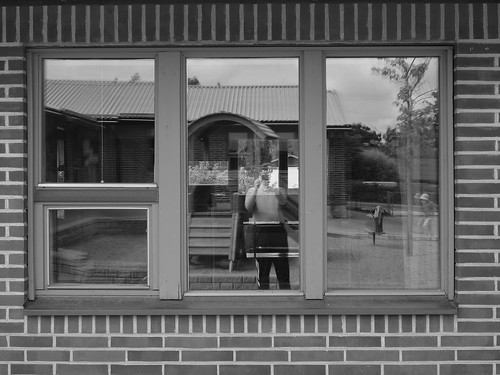I have looked at many b&w photographs during the last days - thanks to reading the books "The Photographer's Eye" by John Szarkowski and "Why People Photograph" by Robert Adams. And so I felt the need to take b&w photographs, at least a few, to find out whether it is possible to "see" in b&w.
As I have noted earlier, I usually see first colors when trying to take photographs, so b&w doesn't come naturally. On the other hand, b&w is more abstract than color, and this does suit my style of photography, so I guess I'll continue making these experiments. The "dynamic b&w" mode of the LX3 helps, as you get a nice preview of the image on the screen, educating you about the possibilities of b&w photography.
I haven't done many self-portraits, and this image is not precisely one either, but I felt it was a fitting subject, as I have been painting window panes during the last week or so. With triple glazing there are a lot of panes to tape and paint. As someone noted on the net, "Have you ever tried to paint [...] window panes? It is awful. ... Taping is also for amateurs and also takes for ever."
Returning to photography books, I have now finished reading the essay collection "Why People Photograph". It was a great book, though suprisingly much of the text focused on environmental and economical issues - the destruction of the America as it used to be.
I wrote here about everyman's right, and Robert Adams points to this topic. It is not so in America as it is in Finland (or Sweden), "where any citizen at all can walk to within sight of any house". Our rights to nature seem to be a kind of utopia Adams was planning towards. Sadly, I don't think things will soon improve in places where the rights of the public have been overriden by the rights of industry.
Another interesting thing was how Adams praised Szarkowski as a critic and curator of photography. And I feel the same. I'm currently reading another book of Szarkowski, "Looking at Photographs: 100 Pictures from the Collection of The Museum of Modern Art". An excellent review of photography!
Friday, July 24, 2009
Portraiture in b&w (with windows) - LX3 dynamic b&w mode
Subscribe to:
Post Comments (Atom)




4 comments:
I really like B&W. As you can see from my blog, I've gone over to mostly black and white. This is mainly because I've gone back to shooting film for while with a medium format camera and I am enjoying it quite a bit!
As much B&W as I have shot, I still don't see in B&W. I have some general ideas of which shots will turn out well and which will not, but I'm still relearning. It's all that I used to shoot. I find that the B&W mode on the back of my D300 is immensely helpful; Fortunately/unfortunately, the back of my film camera offers no such luxury. I have to evaluate the scene, decide, then shoot. I really like the anticipation of seeing the negatives after I develop them. I guess that I'm just a throwback, an anachronism! :-)
I'm really looking forward to reading those books!
I never shot any b&w, although I have taken quite a few rolls of photographs years ago. Now it feels that I will never go back to film, but who knows...
Here's the thing about b&w -- you don't SEE in b&w -- you see the LIGHT - the tonality. If you can get that part right, it'll help your color photography immensely. I hear it quite a bit, "I don't like to shoot b&w because the world isn't b&w" -- ahh - but there is always LIGHT - even at night -- you just need to look for the GOOD light - and record it with b&w film to see what you get -- the more you shoot with it, the more you'll understand the difference between good and bad light...
It took me a long time to figure that out --- but man is it fun when you do....
Nice post...
@bob: Indeed, it is fun to try to catch a b&w photograph.
Post a Comment